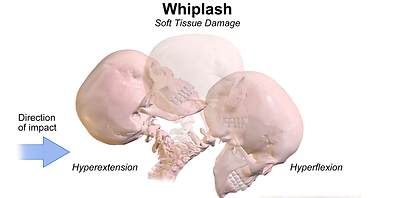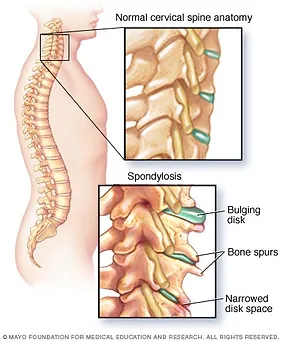The cervical spine (neck) is made up of the first seven vertebrae in the spine. It starts just below the skull and ends at the top of the thoracic spine. The cervical spine has a backward “C” shape (lordotic curve) and is much more mobile than either of the thoracic or lumbar regions of the spine.
The entire spinal column is joined together by ligaments that allow the spine to bend and twist carrying the weight of the human body with just the right balance of strength and flexibility.

Whiplash occurs when the neck is moved beyond its usual range of movement, which overstretches or sprains the soft tissues of the neck (tendons, muscles and ligaments). This causes pain and discomfort in the neck and shoulders and may also cause back pain.
Pain from a whiplash injury often begins 6 to 12 hours after the injury.
Whiplash symptoms often greatly improve or disappear within one to four weeks. It may take longer for symptoms to completely disappear and some people experience some pain and neck stiffness for months after a whiplash injury.

Wry neck, or acute torticollis, is a painfully twisted and tilted neck. The top of the head generally tilts to one side while the chin tilts to the other side.
This condition can be congenital (present at birth) or acquired. It can also be the result of damage to the neck muscles or blood supply.


Between each vertebrae in the cervical spine are discs which act as cushions or shock absorbers and also permit some movement between the vertebral bodies. When the disc buldge is significant enough for the disc nucleus to leak out, it is known as a Herniated disc. A disc bulge can press against or irritate the nerve where it exits from the spine causing a pinched nerve.
Also known as pinched nerve or compressed nerve is caused from disc bulges, disc degeneration, soft tissue compression or scar tissue. Symptoms include: Neck, shoulder or upper limb pain, pins and needles, numbness and reduced movement in the neck.
There are numerous different types of headaches which can be caused from a number of factors. They can be classified into two categories; Primary Headaches and Secondary Headaches.
Primary Headaches are disorders by themselves. They are caused by their own pathomechanism and not as a result of another condition.
Secondary Headaches result as a symptom of another condition, such as meningitis.

There are approximately 5 Million people in Australia suffer from headaches and more than 150 different types of headaches (ICHD)
Causes include; Stress, Hormones, Posture, Muscle Tension, Blood Pressure Changes, Medication, Dehydration, Gut Dysfunction
Soft tissue OT helps to reduce the tension in the muscles, decrease inflammation around the joints and restore blood flow.